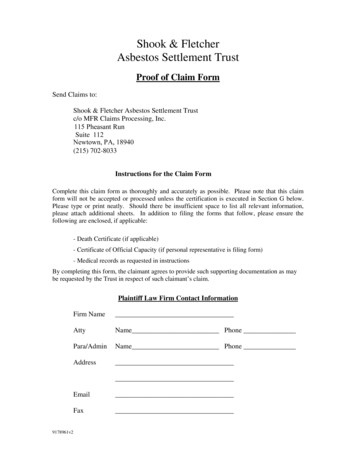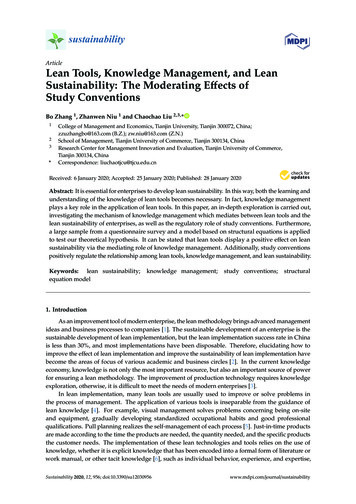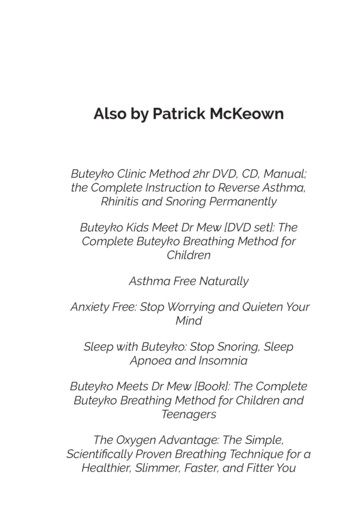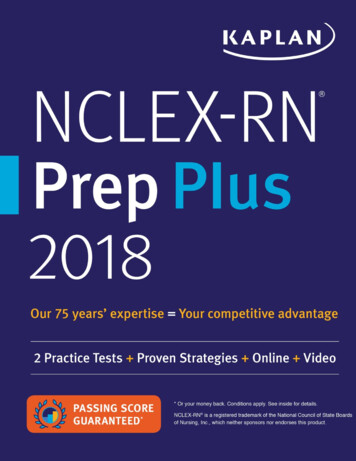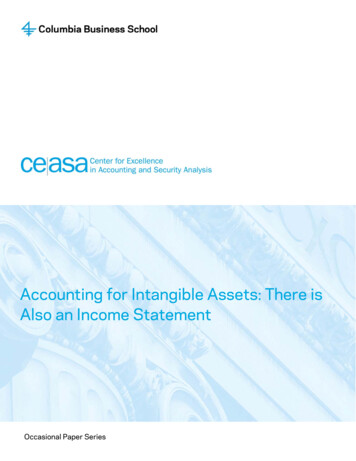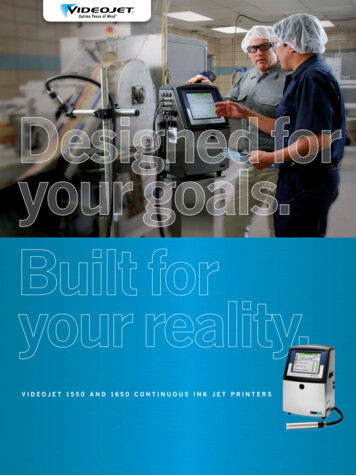
Transcription
Also by John ShookLearning to See: Value Stream Mapping to Add Value and Eliminate MudaKaizen Express Copyright 2008 The Lean Enterprise Institute, Inc.One Cambridge Center, Cambridge, MA 02142 USATel: 617-871-2900 Fax: 617- 871-2999 lean.orgISBN 978-1-934109-20-5All Rights Reserved.Design by OffPiste Design, Inc.Printed in the USAOctober 2008
Managing to LearnUsing the A3 management process to solve problems,gain agreement, mentor, and leadby John ShookForeword by Jim WomackThe Lean Enterprise InstituteCambridge, MA, USAlean.orgVersion 1.0October 2008
AcknowledgmentsI’m indebted to more people who helped make this book possible than I can possibly thank.My debt of gratitude begins with my many mentors at Toyota. Whatever I have learnedabout management and the A3 process owes everything to them. For my first managers,Isao Yoshino and Ken Kunieda, teaching me the A3 process wasn’t merely an act ofkindness on their part—they desperately needed me to learn the thinking and gain theskills so I could begin to make myself useful. From learning as a novice under theirguidance to years later assisting Mike Masaki address the challenge of introducingA3 thinking to an organization of American engineers, my mentors have been many andmy learning constant.I also have many to thank for specific help in writing this book. Mathew Lovejoy, ScottHeydon, Lynn Kelly, Eric Ethington, Cindy Swank, and Jerry Bussell each providedinsightful and critical feedback from the perspective of executives learning to use theprocess to make real progress in their companies.Jack Billi and Denise Bennett helped me appreciate the powerful role the A3 process canplay in introducing lean thinking to complex healthcare organizations. The manuscriptitself benefited greatly and specifically from Jack’s insights and red pen.Durward Sobek, Art Smalley, and Mike Rother were all, coincidentally, writingmanuscripts on related topics at the same time; this book grew more than a little fromour ongoing discussions and collaborations. Richard Whiteside and Terry Vigdorthprovided commentary challenging both the concepts and the presentation that wasvaluable in shaping the story.David Verble and Jeff Smith, two fellow ex-Toyota colleagues with whom I have sharedthis learning journey for many years, read the manuscript and provided predictablycritical and, therefore, especially valuable feedback: Your names both appear brieflyelsewhere within these pages—they could appear on each page.Thanks, too, for critical feedback from Tom Waters and Tim Andree, fellow veteransof A3 wars from years we spent together on the front lines of Toyota in Japan backin the 1980s.ivManaging to Learn
Of course, collaboration from the Lean Enterprise Institute community has beeninstrumental. David Brunt and Dan Jones of the Lean Enterprise Academy UK providedvaluable critique, while Jose Ferro, Flavio Picchi, and Gilberto Kosaka at the LeanInstitute Brasil are already hard at work on the Portuguese translation! Special thanksare due to Dave LaHote, Dave Logozzo, and Helen Zak for ongoing support andencouragement on this and other collaborations, as well as LEI staff who offered theircritiques through the process. Michael Brassard provided advice, critique, debate, andinsights—this book would not be what it is without the support you provided.The editorial team of George Taninecz, Tom Ehrenfeld, and Thomas Skehan made hardwork fun, fun work productive, and productive work rewarding. I hope you are readyfor Round Two.Jim Womack deserves special gratitude for his encouraging and cajoling to write thisbook to begin with. Jim often states that the most significant help he provides individualsalong their lean journey (a phrasing that Jim hates, and I therefore gleefully use here) isto simply provide them with courage: In this case, at least, there would be no book wereit not for Jim’s encouragement.Most of all, this is dedicated to my son Jesse, a lieutenant in the United States MarineCorp, and daughter Saya, going to school full-time and working full-time in Tokyo; youdon’t how much you inspired me as I was writing this. This is for you, as you embarkon your own journeys of life and learning to destinations unknown.John ShookAcknowledgementsv
ForewordI’m enormously excited about this book. John Shook’s Managing to Learn seeks toanswer a simple but profound question: What is at the heart of lean management andlean leadership?In addressing this question, Managing to Learn helps fill in the gap between our understanding of lean tools, such as value-stream mapping, and the sustainable application ofthese tools. In the process it reveals: The distinction between old-fashioned, top-down, command-and-controlmanagement and lean management. The difference between an organization based on authority and one basedon responsibility. The enduring benefits realized by managers who dig deep in the details todiscover root causes rather than jumping to solutions. The power of creating lean managers and leaders through the process ofsolving problems and implementing plans.Managing to Learn shines a bright light on the many dimensions by which the leanmethod is superior to today’s dominant approach to management and to leadership(which are often nothing more than firefighting). Perhaps most extraordinarily,this book shows how this better method of management is taught and learned throughdialogue about concrete problems. It does this by means of a dialogue between a leanmanager and a subordinate who learns lean management and leadership as he solvesan important problem.This process of solving problems while creating better employees—A3 analysis—is coreto the Toyota management system. An A3 report guides the dialogue and analysis. Itidentifies the current situation, the nature of the issue, the range of possible countermeasures, the best countermeasure, the means (who will do what when) to put it intopractice, and the evidence that the issue has actually been addressed.This volume describes A3 analysis and provides examples of how to use the tool. Butits truly important contribution is to explain the thought process behind the tool—A3thinking. Indeed, A3 thinking turns routine managing into cumulative learning for thewhole organization. Hence the title, Managing to Learn.Because A3 thinking is so different from conventional management thinking, onlysomeone who actually has experienced it as an employee and deployed it as a managercan fully explain its nuances. John is therefore the ideal author. He was hired in 1983as an employee at Toyota in Japan, where he learned A3 as the pupil, the deshi. As hebecame a manager he practiced A3 as the teacher, the sensei. At the same time, he wasviManaging to Learn
still the deshi of higher-level mangers, whose core management tasks included teachingadditional aspects of A3 analysis to everyone they managed.John’s job eventually became to help manage the transfer of Toyota’s lean managementsystem across the world. He began this work at the NUMMI joint venture with GeneralMotors in 1984, and continued with the startup of Toyota’s Georgetown facility in1986. Next, he transferred to Toyota’s rapidly expanding North American engineeringcenter in Ann Arbor, MI, and then finished his Toyota career helping launch the ToyotaSupplier Support Center in Kentucky. At every stop he taught A3 thinking by mentoringyounger managers and employees, and continued his own learning through A3 dialoguewith his superiors. Since leaving Toyota he has taught these principles to organizationsacross the world.John’s book is a unique achievement in explaining a vital management tool while at thesame time revealing the thought process behind its use. To achieve this dual purpose thebook employs a unique layout. The thoughts and actions of the lower-level manager areon the left side of the page and the simultaneous thoughts and actions of the higher-levelsupervisor are on the right side. You will see a learning process unfolding as a complexproblem is solved and a new lean manager is created.The transition to A3 management is a major leap for all of us. It demands that wemanage by PDCA (plan, do, check, act), the scientific method, and science is hard work.We all want to jump to conclusions about what to do, and then be given the freedomas managers to “just do it.” Yet A3 thinking continually pulls us toward a much moreconstructive reality. There we look hard at the current situation, dig deep to discoverthe root cause of problems, consider many countermeasures (not just the most obvious“solution”), rigorously lay out an implementation plan, and carefully collect data to seeif our countermeasure has really improved the situation. And then we repeat this cycle.In Managing to Learn, John has captured the thought process behind lean managementand leadership. And he has provided the methods you will need to succeed with A3analysis. This way of thinking is essential to gaining and sustaining the benefits of thelean tools you have already mastered.We are eager to hear about your successes as well as your difficulties. Please contactus and John by sending your comments and questions to mtl@lean.org. With a bit ofpractice and a lot of perseverance, we can all manage to learn.Jim WomackChairman, Lean Enterprise InstituteOctober 2008Forewordvii
ContentsForewordIntroductionChapter 1: What Is an A3?Chapter 2: Grasp the Situation—Go to the GembaChapter 3: Goals and Analysis—Finding the Root CauseChapter 4: Proposed Countermeasures—Set-Based Decision-MakingChapter 5: Plan and Followup—Pull-Based AuthorityChapter 6: Perpetual PDCA—Developing A3 ThinkersConclusion—Learning to LearnGetting Started—It Takes Two to A3About the AuthorBibliographyFeedbackA3 Examples
IntroductionAt Toyota, where I worked for more than 10 years, the way of thinking about problemsand learning from them for more effective planning, decision-making, and execution isone of the secrets of the company’s success. The process by which the company identifies,frames, and then acts on problems and challenges at all levels—perhaps the key to itsentire system of developing talent and continually deepening its knowledge and capabilities—can be found in the structure of its A3 process.And so this book is designed to help you learn from your problems as you seek to solvethem, while at the same time producing innovative and problem-solving employees.Many elements of the Toyota system have been held up as the key to its tremendoussuccess, but the most important accomplishment of the company is simply that it haslearned to learn.Many people familiar with A3 reports see them primarily as a simple communicationtool or problem-solving technique. It’s understandable that they focus on this immediate,though limited, application. A3s are, indeed, powerful tools that lead to effective countermeasures based on facts. As a result, companies that successfully implement them fordecision-making, planning, proposals, and problem-solving can realize instant gains.But in this book I also want to reveal A3 as a management process. The widespreadadoption of the A3 process standardizes a methodology for innovating, planning,problem-solving, and building foundational structures for sharing a broader and deeperform of thinking. This produces organizational learning that is deeply rooted in thework itself—operational learning.Discovery at ToyotaI discovered the A3 process of managing to learn firsthand during the natural course ofmy work in Toyota City beginning in 1983. I was mentored and saw my Japanesecolleagues both being mentored and mentoring others in the company’s most prevalentmanagement tool—its most visible form of organizational “currency.” My colleaguesand I wrote A3s almost daily. We would joke, and lament, that it seemed we wouldregularly rewrite A3s 10 times or more. We would write and revise them, tear them upand start over, discuss them and curse them, all as ways of clarifying our own thinking,learning from others, informing and teaching others, capturing lessons learned,hammering down decisions, and reflecting on what was going on.Introduction1
Every year I saw new Toyota recruits, just graduated from the university, arrive at theirdesks to find a blank sheet of A3-sized paper, a mentor, and a problem or project forwhich they were assigned ownership. Over the course of the first months, each wouldbe coached through A3 thinking. They explored how to “go see” and comprehend thereal nature of a problem, how to analyze it, and how to take effective initiative to workthe organization to develop reasonable countermeasures to improve the situation.My own epiphany came when my boss told me, “Never tell your staff exactly what todo. Whenever you do that, you take responsibility away from them.” His commentsrevealed how Toyota operates not as an “authority-based” but a “responsibility-based”organization. Almost all organizations (certainly all large ones) are cross-functional inoperation while being functional in structure. This results in a matrix that so oftenleaves ownership unclear, decision-making stymied, and everyone frustrated.Pull-Based AuthorityIn stark contrast, effective use of the A3 process can facilitate the shift from a debateabout who owns what (an authority-focused debate) to a dialogue around what is theright thing to do (a responsibility-focused conversation). This shift has a radical impact onthe way decisions are made. Individuals earn the authority to take action through themanner in which they frame the issue. They form consensus and get decisions made byfocusing relentlessly on indisputable facts that they and their peers derive from the gemba.However, for leaders to refrain—as much as possible—from dictating does not meanlaissez-faire disengagement. As we shall see, the Toyota leader engages in the messydetails of the work being done in order to learn and become thoroughly knowledgeableabout the process at hand. Que
Managing to Learnshines a bright light on the many dimensions by which the lean method is superior to today’s dominant approach to management and to leadership (which are often nothing more than firefighting). Perhaps most extraordinarily, this book shows how this better method of management is taught and learned throughFile Size: 763KBPage Count: 46
